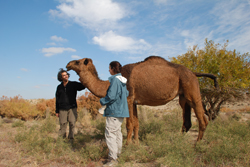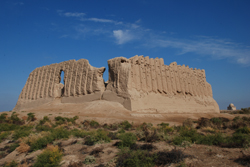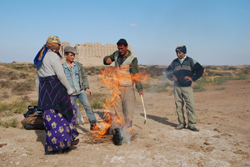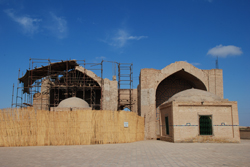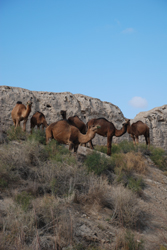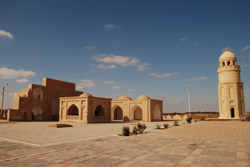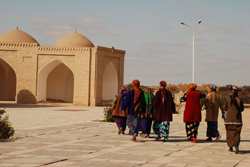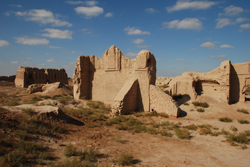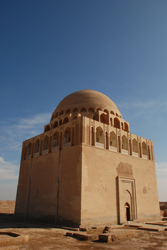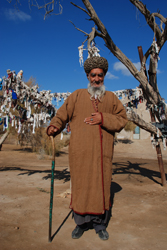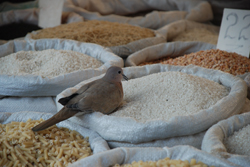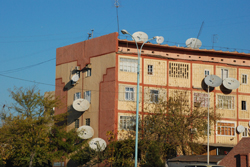The Ancient City of Merv
1 November, 2008, 03:52 am in "Turkmenistan"
I had a fear that the ruins of the ancient city of Merv would be no more than piles of mud. After all, mud was the common building material of the area and didn't seem to hold up well under centuries of weather. I prepared myself for an unimpressive expanse of melted mud lump remains of walls.
So, I was pleasantly surprised when the mud walls of the Abdullah Khan Fortress, the first site we passed of Merv, had some rounded towers intact within its rather sizable melting mud walls. As we drove to the entrance of the ruins complex, I could see some actual buildings.
After a brief stop for buying tickets and glancing at the museum, we drove to the Kiz Kalas, which were built in the 6th and 7th centuries. They were made from adobe bricks and many walls were still intact as well as some arches and stairways. The walls on the exterior were made up of brick pillars set together which gave it a corrugated look. From the distance they looked like giant organ pipes. I wonder if this wall design helped shield the walls from the elements and preserve them. Through holes in the walls we could see fields with herds of camels grazing.
The area around Merv is dry with prickly plant life. But the colors are soft varigated shades of green, gold and red. The remaining structures are creamy beige—most adobe brick buildings some with brick domes coated with mud. At the smaller fortress, a family of shepherds quickly lit a fire. The women here wear long skirts that are tighter fitting than in other parts of Central Asia-- more closer to the style I like. They had long colorful scarves wrapped around their heads.
From the Kalas' we visited the mausoleums of the two Askhabs (friends of the Prophet). One of the mausoleums was completely under scaffolding but the other was visible. In front of them was a cistern with undrinkable water inside and the remains of some plaster floral designs at the entrance.
Beyond these we came upon a herd of grazing camels. It occurred to me camels faces are kind of like flamingos. Their expression has that same drooping somewhat comical upside down look.
Merv is an extremely spread out site. The road winds in and out of mud walls of ancient fortresses. In some places the ground is littered with pottery shards. The remains date from the 6th Century BC through the present restorations and re-buildings.
As Merv fell and was rebuilt, the location was changed to follow the changes in the river. So, unlike other ancient cities where the new cities was built on the remains of the old, the new was built in a different location next to the old one which was abandoned.
The Mosque of Yusuf Hamadani seemed mostly new but I guess he was a figure from the 12th century. We climbed an ornate minaret and saw people walking to an area behind the tomb and crawling under a blanket (or something that looked like a blanket... maybe it was a robe.) From there we visited the Shahriyar Ark which had some more pipe organ walls.
As Merv fell and was rebuilt, the location was changed to follow the changes in the river. So, unlike other ancient cities where the new cities was built on the remains of the old, the new was built in a different location next to the old one which was abandoned.
The Mosque of Yusuf Hamadani seemed mostly new but I guess he was a figure from the 12th century. We climbed an ornate minaret and saw people walking to an area behind the tomb and crawling under a blanket (or something that looked like a blanket... maybe it was a robe.) From there we visited the Shahriyar Ark which had some more pipe organ walls.
The most impressive structure in the area is the Mausoleum of Sultan Sanjar. It had been restored in 2002-03 by Turkey. It is a Selcuk building and towers above everything. Perhaps it is even taller than most of the historic buildings we've seen in Central Asia. It is crowned by a huge dome. The building is a simple block shape but has an ornate terraced area near the top with arches decorated with ganch designs and wood grated frames. Inside there was a splendid echo which transformed every sound into a flurry of noise-- a quiet roar.
From there we stopped by the Mausoleum of Mohammad Ibn Zeid, a 12th century buiding with modern restoration. I was walking around it when I ran into an old man with a traditional Turkmen robe and hat. He informed me I was walking the wrong way. I thanked him for the reminder and started walking anti-clockwise which is how you are supposed to walk around holy tombs.
We had time to walk around Mary after visiting Merv. There were not a lot of people on the street. The bazaar was low key. Of course, it was a Sunday so maybe things are more active during the week. We got a bit disoriented trying to walk back to the hotel. Then Rowshan saw a Gold Turkmenabashi statue. “I recognize that statue!” he said. I joked that it isn't wise to use gold Turkemabashi statues as landmarks in Turkmenistan since each town can have several. Later Rowshan said he recognized the concrete apartment building covered with satellite dishes, another not so reliable landmark in Mary. However, we were on the correct road and eventually got to the hotel.
Comments
- Comments
Powered by My Blog 1.69. Copyright 2003-2006 FuzzyMonkey.net.
Created by the scripting wizards at FuzzyMonkey.net..
(Code modified by Rowshan Dowlatabadi)
Created by the scripting wizards at FuzzyMonkey.net..
(Code modified by Rowshan Dowlatabadi)


